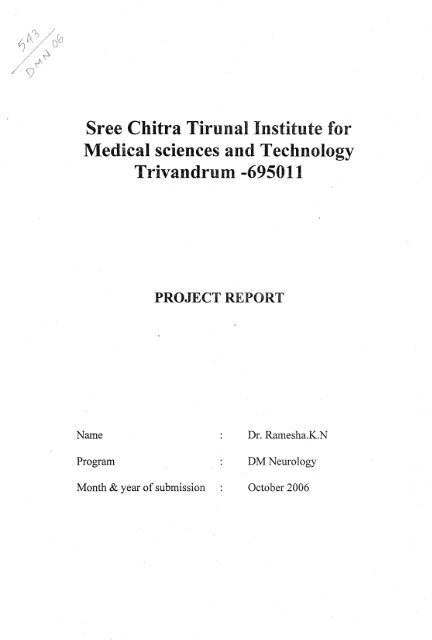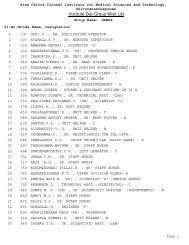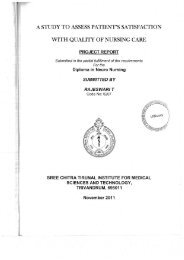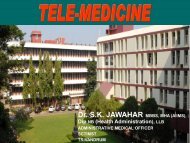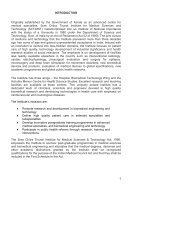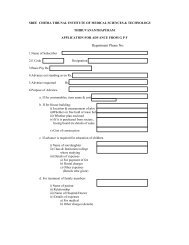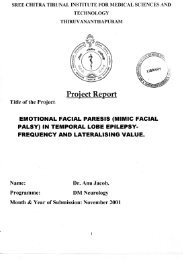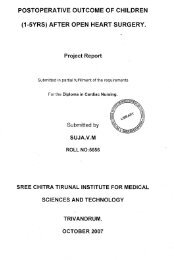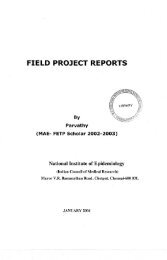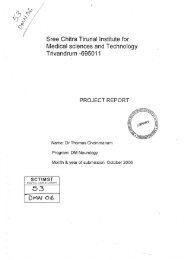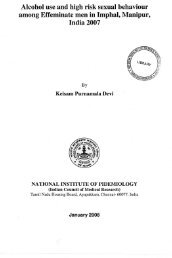Sree Chitra Tirunal Institute for Medical sciences and Technology ...
Sree Chitra Tirunal Institute for Medical sciences and Technology ...
Sree Chitra Tirunal Institute for Medical sciences and Technology ...
You also want an ePaper? Increase the reach of your titles
YUMPU automatically turns print PDFs into web optimized ePapers that Google loves.
<strong>Sree</strong> <strong>Chitra</strong> <strong>Tirunal</strong> <strong>Institute</strong> <strong>for</strong><strong>Medical</strong> <strong>sciences</strong> <strong>and</strong> <strong>Technology</strong>Triv<strong>and</strong>rum -695011PROJECT REPORTNameProgramDr. Ramesha.K.NDM NeurologyMonth & year of submission October 2006
CERTIFICATEI, Dr. Ramesha .K .N, hereby declare that I have actually carried out theproject under reportPlace: Triv<strong>and</strong>rumDate: 12.10.2006Signature =·Dr. Ramesha.K.NForwarded, he has carried out the project under reportSignature~~/~ Dr. Abraham ~uruvillaAssociate ProfessorDepartment ofNeurologySCTIMST, Triv<strong>and</strong>rum
PROJECT REPORTCLINICAL, ELECTOPHYSIOLOGICAL ANDHISTOPATHOLOGICAL CORRELATIONSIN INFLAMMATORY MUSCLE DISEASENameProgramDr. Ramesha.K.NDM NeurologyMonth & year of submission October 2006
ACKNOWLEDGEMENTI wish to express my heartfelt gratitude towards my teacher, Dr AbrahamKuruvilla, Associateprofessor of Neurology, who has been my thesis guide.He has carefully guided me through out the study, without which I might nothave been able to accomplish the goal.I express my sincere gratitude to Dr. K.Radhakrishnan, Professor <strong>and</strong> Headof the department of Neurology in taking keen interest in the study.I am very grateful to Dr. Muralidharan Nair, Professor, department ofNeurology <strong>for</strong> his constant guidance.I am also thankful to staff members of the medical record department, whoprovided necessary help in data collection.I am thankful to Dr Sarma, statistician, in helping me <strong>for</strong> carrying out thestatistics part. ·Most importantly, I thank all my patients in sincerely participating in thestudy, without co-operation of whom, this study would never have beenpossible
CONTENTS1. INTRODUCTION2. REVIEW OF LITERATURE3. AIMS AND OBJECTIVE4. PATIENTS AND METHODS5. RESULTS6. DISCUSSION7. CONCLUSION8. REFERENCES9. APPENDIX
INTRODUCTIONThe inflammatory myopathies are simply those disorders in which the primarypathological process is inflammation within muscle. In most, the main clinicaiconsequence is weakness, much less frequently pain. This definition thus excludesmyopathies with secondary inflammation in muscle, such as some of the musculardystrophies, <strong>and</strong> conditions in which the inflammatory process is in associated tissuesrather than muscle itself, such as polymyalgia rheumatica. These latter conditions areparticularly important as they may be misdiagnosed <strong>and</strong> mistreated as being <strong>for</strong>ms ofmyositis. ·The inflammatory myopathies are rare. No accurate figures <strong>for</strong> incidence orprevalence are available but if one takes the two most common conditions,dermatomyositis <strong>and</strong> inclusion body myositis, their combined annual incidence ISprobably less than 200 new cases per annum in the UK (population ~60 million).In perhaps 70% of cases, the diagnosis <strong>and</strong> management are straight<strong>for</strong>ward <strong>and</strong>successful· With respect to drug treatment there is an absolute dearth of r<strong>and</strong>omisedcontrolled trials <strong>and</strong> the best advice that can be offered is based on "expert opinion".Multicentre trials are desperately needed6
• IdiopathicClassification of the inflammatory myopathies-dermatomyositis (DM)- polymyositis (PM)- inclusion body myositis (IBM)• Associated with connective tissue diseases-systemic lupus erythematosus- mixed connective tissue disease- scleroderma-Sjogren's syndrome-rheumatoid arthritis• Infective- viral (Coxsackie, influenza, HIV, HTL V I)-parasitic-bacterial-fungal• Miscellaneous- eosinophilic myositis-associated with vasculitis-granulomatous (<strong>for</strong> example, sarcoid)- orbital myositis- graft v host disease ·- macrophagic myofasciitisDermatomyositis (DM) is the most common <strong>for</strong>m of classical inflammatorymyopathy. Isolated polymyositis (PM) is rare, but a frequent misdiagnosis. But PM isrelatively frequently associated with various manifestations of connective tissue disease, asituation <strong>for</strong> which many use the term "overlap syndrome". Some argue that there is adifference between "overlap" <strong>and</strong> "association" but in truth we are currently ignorant ofthe true relationship between these various conditions. Debate continues as to whetherinclusion body myositis (IBM) is a primary inflammatory myopathy, or whether theinflammatory changes are a secondary phenomenon. One of the strongest arguments infavour of the latter is that IBM responds poorly, ·if at all, to immunosuppressant/antiinflammatorytreatments. IBM is often initially wrongly diagnosed <strong>and</strong> treated as PM,usually because. of failure to appreciate the specific clinical <strong>and</strong> pathological features ofthe condition.7
PATHOGENESISFor a long time, DM <strong>and</strong> PM were considered to be essentially identical disorders,differing only by the presence or absence of skin involvement. There is nowoverwhelming evidence that they are fundamentally different disorders in term ofpathogenesis . It is likely that in the future their differing pathogeneses will lead tospecific immunomodulatory treatments <strong>for</strong> each disorder, but that is not so at present <strong>and</strong>treatment, as <strong>for</strong> other autoimmune disorders, takes the <strong>for</strong>m of a "blruiderbuss" approachto immunosuppressionDM is a humorally mediated autoimmune disorder. Complement dependent attackleads to destruction of capillaries in muscle <strong>and</strong> other tissues. In muscle, the resultingmicroangiopathy leads to the characteristic pathological features of infarction <strong>and</strong>perifascicular atrophy. Whether it is deposition of circulating immune complexes or thebinding of an antibody to an endothelial antigen which triggers this lytic complementpathway is unknown.PM is caused by a cell mediated immune phenomenon. Autoinvasive CDS+ T cells,recognising an unknown muscle antigen, invade non-necrotic muscle fibres expressingclass 1 major histocompatibility complex antigen (MHC-1) <strong>and</strong> lead to their destruction.In IBM, although there is some similarity with the immunocytological findings seenin PM, there is evidence that the fundamental pathological process is different <strong>and</strong> that atleast some of the inflammatory <strong>and</strong> immune changes seen in IBM may be epiphenomena.Similarities have been drawn between the pathological findings in muscle in IBM <strong>and</strong>those in the brain in Alzheimer's disease, but again whether these are primary orsecondary phenomena has yet to be determined.8
CLINICAL FEATURESMany inherited myopathies (<strong>for</strong> example, the muscular dystrophies) arecharacterised by highly selective involvement of specific muscles, with physicallyadjacent muscles showing notably different degrees of involvement . Selectivity, which isa powerful diagnostic tool <strong>for</strong> the appropriately experienced clinician, is not a feature ofDM or PM, but is evident in many cases ofiBM.In DM <strong>and</strong> PM, as in so many acquired myopathies (<strong>for</strong> example, endocrine <strong>and</strong>drug induced myopathies), the characteristic feature is generalised proximal musclewasting <strong>and</strong> weakness, with the pelvic girdle musculature nearly always being moreseverely affected than the shoulder girdle muscles (presentation with shoulder girdleweakness is unusual). The typical symptoms include difficulty climbing stairs <strong>and</strong> risingfrom a low chair, <strong>and</strong> difficulty with tasks at <strong>and</strong> above shoulder height such as selfgrooming <strong>and</strong> lifting objects onto shelves. Distal weakness is a late feature <strong>and</strong> is never assevere as proximal weaknessIn contrast, IBM often shows remarkably selective muscle involvement, with the mostcharacteristic pattern being wasting <strong>and</strong> weakness of quadriceps (<strong>and</strong> it is almost certainlythe most common cause of what used to be called "isolated quadriceps myopathy") <strong>and</strong> ofthe long finger flexors. The clinical consequences are falling, caused by the knees givingway, <strong>and</strong> weakness of grip. In other words, the most fundamental functions of the lower<strong>and</strong> upper limbs, respectively, are compromised <strong>and</strong> the disease can cause profoundfunctional disability.In addition to these general observations about the pattern of muscle involvement,each disease also has additional clinical characteristics <strong>and</strong> associations.DermatomyositisDM can affect all ages but the disease in children differs somewhat from that inadults; general misery rather than obvious weakness may be the presenting feature,· subcutaneous calcification is more common, the face may be flushed without the morespecific characteristics of the rash seen in adults, <strong>and</strong> the bowel may be involved. Inadults the disease usually presents subacutely with symptoms evolving over severalweeks, but less commonly the onset can be very acute· with widespread muscle <strong>and</strong>subcutaneous oedema. Patients with severe disease may develop respiratory failure.Dysphagia, with risk of aspiration, is also common in severe disease.About 20% of cases, more in the older population, are associated with anunderlying malignancy <strong>and</strong>, as with other paraneoplastic disorders, the neoplasm may not9
eveal itself until some considerable time (possibly 2-3 years) after first presentation.Unlike, <strong>for</strong> example, Lambert-Eaton myasthenic syndrome, there is not a closeassociation with one particular site or type of tumour.Skin rash is evident in most patients <strong>and</strong> is often the first symptom. It may beabsent throughout , the diagnosis then resting on the characteristic muscle biopsy findingsin DM, be fleeting <strong>and</strong> rather non-specific (<strong>for</strong> example, facial or chest erythema), or bedifficult to see in dark skinned individuals (<strong>and</strong> note that the incidence of D M is higher inthose of Afro-Caribbean origin). Dermatologists may see DM without apparent muscleweakness , but in most of those patients muscle biopsy will show characteristicabnormalities.The rash has many similarities with that seen in systemic lupus erythematosus,<strong>and</strong> indeed there are pathological features in common including the presence ofundulating tubules in capillary endothelial cells. Both show photosensitivity. The typicalcutaneous features of DM include erythema over the light exposed cheeks (malardistribution), upper anterior chest (V sign), upper posterior chest (shawl sign), <strong>and</strong>knuckles. The eyelids may be oedematous <strong>and</strong> show purple (heliotrope) discolouration,but this is a less constant feature than the less specific erythema <strong>and</strong> the h<strong>and</strong> signs. Aswell as erythema there may be a scaly eruption (Gottron's sign) over the knuckles, but thephalanges are spared. Dilated capillaries may be seen at the base of the fingernails. A dry,cracked, appearance to the h<strong>and</strong>s is referred to as "mechanic's h<strong>and</strong>s"; it is often, but notinvariably, associated with the presence of anti-synthetase antibodies, including anti-Jo-1.Interstitial lung disease is seen in about 10%, <strong>and</strong> is occasionally the presentingproblem. Here . there is a strong association with the presence of anti-synthetaseantibodies, particularly anti-Jo-1. It may potentially be confused with methotrexateinduced pneumonitis when that drug is used to treat the myositis. Myocarditis <strong>and</strong>conduction abnormalities may be seen, particularly in severe acute disease. Morbidity <strong>and</strong>mortality in DM relate mainly to interstitial lung disease, myocardial involvement, <strong>and</strong>the complications of respiratory failure secondrur to respiratory muscle weakness.10
PolymyositisEvolution of weakness is slower than in DM, typically over months, but generallyfaster than in IBM. Dysphagia <strong>and</strong> facial weakness are uncommon. It is a disease of adultlife. It is uncertain whether PM is associated with malignancy, but if it is the link is lessstrong than <strong>for</strong> DM, <strong>and</strong> on current evidence extensive searching <strong>for</strong> an underlyingmalignancy is not ·justified. The uncertainty is because earlier studies used obsoletecriteria to distinguish between PM <strong>and</strong> DM.PM is never associated with the cutaneous features of DM. As in DM, interstitiallung disease is associated with anti-Jo-1 <strong>and</strong> other myositis specific antibodies.Myocardial involvement may occur.Pure" PM is rare, but as noted below PM may be associated with othermanifestations of connective tissue disease. A diagnosis of PM is frequently made inerror . "Treatment resistant" PM is usually the result of an incorrect diagnosis, most oftenIBM, <strong>and</strong> indeed many patients with IBM have finally been correctly diagnosed onlyafter failure to respond to immunosuppression. Failure to diagnose IBM at the outset istypically due to not appreciating the specific pattern of muscle weakness, in particularmissing ·finger flexion weakness, <strong>and</strong> failing to appreciate the specific pathologicalfeatures, notably rimmed vacuoles <strong>and</strong> filamentous inclusions. Muscular dystrophy may. be mistaken <strong>for</strong> PM, most often when the duration of symptoms appears to be short. Thepattern of weakness may be very helpful in making a distinction. Secondary inflammatoryinfiltrates may cause pathological confusion, especially in dysferlinopathy <strong>and</strong>facioscapulohumeral muscular dystrophy.Diseases commonly misdiagnosed as polymyositis• Inclusion body myositis• Dermatomyositis sine dermatitis• Muscular dystrophy-limb-girdle muscular dystrophy type 2B ( dysferlinopathy)-Becker (especially when adult onset)• Endocrinopathy• Drug induced myopathy• Metabolic myopathies- acid maltase deficiency-McArdle's deficiency (myophosphorylase deficiency)11
• Neurogenic disorders- late onset spinal muscular atrophy- motor neurone disease- "Fatigue" syndromesFinally, the diagnosis of PM is often wrongly made in the rather commonsituation of a patient with pain, symptomatic but not objective weakness, <strong>and</strong> modestelevation of the SCK. Muscle biopsy may show minor "abnormalities" which are wronglytaken to confirm the diagnosis of PM. Steroids may offer a brief honeymoon period ofimprovement. Looking at such patients more carefully, one notes that their pain is notentirely in the muscles, but also affects their joints <strong>and</strong> sometimes their skin <strong>and</strong> bones.What they describe as weakness is more a difficulty in sustaining ef<strong>for</strong>t. Initialexamination may suggest weakness, but with encouragement <strong>and</strong> functional tests such asrising from a squat it becomes apparent that there is no true weakness. Most laboratoriesquote an upper normal concentration of SCK that is too low. Values are higher in menthan women, <strong>and</strong> in blacks than whites. A normal male undertaking modest physicalactivity may have concentrations as high as 600 IU/1. Somebody undertaking morevigorous exercise, <strong>and</strong> particularly if black, may have values up to 1000 lUll. Thedifficulty, of course, is knowing whether a concentration of, say, 450 IU/1 in somebodycomplaining of muscle pain is relevant or not. Patients with this type· of problem shouldnever be put on steroids without a muscle biopsy. But they are, <strong>and</strong> when their symptomscontinue <strong>and</strong> they then have a biopsy it may be impossible to interpret the findings. Thecorrect diagnosis in this rather common group of patients may prove to be elusive.Inclusion body myositisThis is the most common acquired myopathy in those over 50 years of age. It issubstantially more common in men, an unusual feature <strong>for</strong> an autoimmune disease <strong>and</strong>another factor that has cast some doubt as to whether it is a true primary inflammatorymyopathy. Infrequently, it can present as early as the third decade. Familial instanceshave been recorded. It is more correctly designated as sporadic IBM to distinguish it fromthe much rarer inherited IBM. This includes dominant <strong>and</strong> recessive <strong>for</strong>ms, which shareclinical <strong>and</strong> pathological features with sporadic IBM, with the notable exception ofabsence of inflammatory infiltrates.The major clinical features of IBM have already been discussed, but it meritsrepetition to emphasise that the presence of distal weakness that is as severe or morepronounced than the proximal weakness in the same limb is highly characteristic. This isusually most evident <strong>for</strong> the finger flexors, but ankle dorsiflexion weakness may also bepronounced. Another feature of ffiM, but not PM or DM, is asymmetric muscleinvolvement, sometimes pronounced. Mild facial weakness may be seen even when limbweakness is relatively mild (rare in DM <strong>and</strong> PM), <strong>and</strong> dysphagia can be an early or latefeature.12
The rate of progression is typically slower than in PM. Elderly patients frequentlycannot easily date the onset of the problem, as they attribute early symptoms to thenormal effects of aging. Substantial quadriceps wasting <strong>and</strong> weakness is frequentlyevident on first presentation. A major practical problem is falling caused by an inability tolock the knees.Myositis specific antibodies are much less frequent in IBM compared with DM<strong>and</strong> PM. Similarly, associated conditions are less frequent, but there are reports of IBM inassociation with Sjogren's syndrome, hepatitis C, HTL V -1 infection, <strong>and</strong> sarcoidosis.Overlap/associated syndromesRather than trying to define specific associations ("splitting"), on the basis of ourcurrent somewhat limited knowledge, it is perhaps best to simply note that patients withmyositis may also be found to have features of other connective tissue disorders("lumping"). Many of these associations have been described above. DM may beassociated with features of scleroderma (often with circulating anti-PM-Scl antibodies)<strong>and</strong> mixed connective tissue disease. PM is associated with many systemic autoimmunediseases <strong>and</strong> indeed isolated PM is rare. DM <strong>and</strong> PM may be associated with non-specificsymptoms such as fever <strong>and</strong> arthralgia, <strong>and</strong> with Raynaud's phenomenon. These variousphenomena, together with interstitial lung disease, when associated with anti-synthetaseantibodies, <strong>for</strong>m the main components of the anti-synthetase syndrome. In such patients,the myositic component may be slight <strong>and</strong> initially overlooked. Finally, to avoiddiagnostic confusion, it is worth noting that DM is often associated with the presence ofanti-nuclear antibodies (ANA), often at substantial titre, but without other clinicalfeatures or specific immunological findings associated with SLE. On the other h<strong>and</strong>,patients with SLE may have an associated myositis13
DIAGNOSISSkilled clinical assessment, taking into account all of the factors alreadydiscussed, is arguably the most powerful diagnostic tool, but laboratory confirmation ofthe diagnosis is required in most cases. The "gold st<strong>and</strong>ard" is muscle biopsy.Electromyography, estimation of SCK, <strong>and</strong> detection of myositis specific antibodies maybe helpful. Arguably, a patient with all of the classical clinical features of DM, elevationof the SCK, <strong>and</strong> typical neurophysiological changes does not need a confirmatory musclebiopsy, but overall few cases of suspected myositis should escape biopsy. If managementdifficulties arise, there is often regret if a biopsy was not per<strong>for</strong>med be<strong>for</strong>e initiation oftreatmentSerum Creatinine kinaseDespite its lack of specificity this is an extremely useful test in both diagnosis <strong>and</strong>management. In the vast majority of patients with DM or PM the concentration iselevated, typically to several thous<strong>and</strong> IU/l. It tends to be higher in those with acute onset<strong>and</strong> substantial weakness, <strong>and</strong> lower in those with more chronic disease, but there isconsiderable variability. For unexplained reasons, the SCK occasionally remainsstubbornly normal. Most patients with IBM have an increased SCK, .but typically ratherlower than in DM <strong>and</strong> PM, often around 1000 IU/l. In all of these diseases there may besubstantial fluctuation from day to day, even without treatment.Classical EMG findings in Acute IMD1. Increased insertional activity with CRDs2. Fibrillations & positive sharp waves3. Small polyphasics short duration MUPs4. Most striking <strong>and</strong> constant finding: Early recruitment: full interference withslight volitional ef<strong>for</strong>t.14
Muscle biopsyPathological feature Dermatomyositis Polymyositis Inclusion bodymyositisInflammatory infiltrates Perivascular Endomysia! EndomysialT cells > B cells - + +B cells > T cells + - -Partial invasion of fibres - ++ ++Micro infarcts ++ - -Scattered necrotic fibres - +- +-Perifascicular atrophy ++ - -Zonal myofibrillar loss + - -Rimmed vacuoles - - ++15 nm filaments - - ++MHC-1 expression + ++ ++Table I: Major muscle biopsy findings15
MANAGEMENTDM <strong>and</strong> PM will be considered together, IBM separately. With respect to drugtreatment, <strong>and</strong> also to some extent to general management issues, it must be reiteratedthat there is little guidance from the literature in the <strong>for</strong>m of r<strong>and</strong>omised controlled trials<strong>and</strong> that much of what is presented here is based on personal experience <strong>and</strong> "expertopinion".Dermatomyositis <strong>and</strong> polymyositisAlthough their drug management will be considered together, there are two issuesspecific to the management of DM. Firstly, except in children, the possibility of anassociated malignancy must be excluded, particularly in the older patient <strong>and</strong> those with ahigher risk of malignancy (<strong>for</strong> example, smoker, strong family history, other predisposingillness). Where appropriate, examination should include breast, vaginal, <strong>and</strong> rectalexamination. Imaging should include the chest, abdomen, <strong>and</strong> pelvis. More detailedinvestigations may be suggested by the history-<strong>for</strong> example, colonoscopy in somebodywith altered bowel habit. Reassessment is necessary <strong>for</strong> 1-2 years. Secondly, although theskin rash is likely to respond to systemic immunosuppressant therapy, there are situationswhen topical treatment may also be of value-<strong>for</strong> example, <strong>for</strong> a· severe local skineruption. Furthermore, the rash is photosensitive <strong>and</strong> a sun blocking cream can be veryeffective in reducing cutaneous manifestations.Corticosteroids are the mainstay of treatment. Unanswered questions relate to thespecific preparation <strong>and</strong> dosage regimens, the selection, use, <strong>and</strong> timing of introduction ofother immunosuppressant drugs ("steroid sparing agents"), <strong>and</strong> the place <strong>for</strong> intravenousimmunoglobulin treatmentCorticosteroidsThe vast majority of pa.tients respond to steroids. Failure to respond is most oftencaused by inadequate initial dosage or duration of treatment, less often to lack ofcompliance because of worry about side effects. A few patients appear to be trulyresistant, but respond to other immunosuppressant regimens. Experience suggests thatearly aggressive treatment tends to be associated with a faster response <strong>and</strong> betteroutcome, so all but the most indolent cases are given intravenous methylprednisolone 500mg daily <strong>for</strong> five days, followed by oral prednisolone 1 mg/kg body weight per day, givenas a single morning dose. Once the SCK has returned to normal <strong>and</strong> the patient isimproving, the dosage is reduced by 5 mg on alternate days, so that after 1-2 months thepatient will be on 1 mg/kg body weight on alternate days. Thereafter, the dose is slowlyreduced, depending on clinical response <strong>and</strong> SCK (see below), to determine the minimalmaintenance dose.Open studies have suggested that other steroid regimens might offer a betterbenefit/side effect ratio, but none has been proven in an appropriate r<strong>and</strong>omised16
controlled trial. These have included pulsed high dose oral <strong>and</strong> intravenous regimens, <strong>and</strong>the use of dexamethasone rather than prednisolone .. ImmunosuppressantsThere is enough evidence from the literature <strong>and</strong> personal experience to leave nodoubt that such drugs can be effective. There is currently inadequate data to suggest thatany one drug is superior to another, <strong>and</strong> choice is largely determined by personalexperience, often from using the drug to treat other diseases. Thus, rheumatologists <strong>and</strong>dermatologists tend to use methotrexate (up to 30 mg weekly), as they have experience ofits use in arthritis <strong>and</strong> psoriasis respectively, whereas many neurologists favourazathioprine (2.5 mg/kg body weight per day), having gained experience of its use inmyasthenia gravis <strong>and</strong> immune neuropathies. Methotrexate can cause a pneumonitis, <strong>and</strong>possibly this could be confused with the interstitial lung disease associated with myositis.Cyclosporin (up to 5 mg/kg body weight per day) has been advocated <strong>for</strong> use inchildhood DM, but is also used in the adult <strong>for</strong>m of the disease. Mycophenolate mofetil(2 g daily) is currently in vogue. Cyclophosphamide has been given as intravenous pulses(up to 1 g/m 2 body surface area) <strong>and</strong> as oral treatment (up to 2 mg/kg body weight perday). There is some evidence to suggest that it is particularly helpful in the treatment ofassociated interstitial lung disease.A further question relates to the timing of the introduction of these drugs. It is oftensuggested that they be used if the patient fails to respond adequately to prednisolone, hasserious side effects from prednisolone, or the required maintenance dose of steroids isunacceptably high. The practical problem is that it may take many months, possibly ofcontinuing deterioration, be<strong>for</strong>e the patient can be identified as falling into one of thesecategories. The various immunosuppressant drugs listed above are all slower to act thanprednisolone. Azathioprine is probably the slowest--experience from myasthenia gravisshows that it takes 9-12 months to become effective. All of the other drugs probablywork faster than this, but even so probably take many months to exert their maximaleffect. Because of these issues, <strong>and</strong> paralleling our experience in myasthenia gravis, it isreasonable to start an immunosuppressant drug (our choice is azathioprine) at the sametime as prednisolone, in the expectation that it will eventually allow a lower maintenancedose of prednisolone. This hypothesis has yet to be proven in a r<strong>and</strong>omised controlledtrial.Intravenous immunoglobulinThere have been enough studies to conclude that intravenous immunoglobulin iseffective in both DM <strong>and</strong> PM, but not sufficient data to define its exact position versussteroids <strong>and</strong> immunosuppressant drugs. At present its use is probably best reserved <strong>for</strong>those with disease that is resistant to steroid <strong>and</strong> immunosuppressant drug treatment.17
Monitoring responseThis involves elements of art as well as science. The aim is to taper theprednisolone to find the minimum dose required to hold the disease in remission, whichin some patients on an additioni:ll immunosuppressant drug may be zero. Although it isoften emphasised that one should treat the patient, not the blood test, a rising SCK is acause <strong>for</strong> concern <strong>and</strong> may herald recurrence. On the other h<strong>and</strong>, recurrence, withincreasing weakness, can occur with no increase in SCK. Steroid induced myopathy is atheoretical concern, but appears to be rare on an alternate day dosage regime. As withmany other autoimmune diseases, the disease may be held in pharmacological remission,but "cure" is more elusive. In our experience, long term drug-free remission is morecommon in DM than PM.Inclusion body myositisMost patients with typical IBM do not have a useful response to steroids,immunosuppressant drugs, or intravenous immunoglobulin. If after in<strong>for</strong>med discussionthey are keen to attempt drug treatment, then I would use an 18-24 month trial ofprednisolone <strong>and</strong> azathioprine (or methotrexate) as outlined above. The prednisolonewould be tapered until the SCK started to rise. Treatment would only continue if therewas unequivocal benefit. The potential side. effects should not be underestimated <strong>and</strong> inthe ·last year we have seen death from cytomegalovirus pneumonia, <strong>and</strong> salmonellainfection in an artificial hip.Atypical cases make me more inclined to propose a trial of treatment, but as yetthe evidence base <strong>for</strong> doing 'this is lacking. Features might include onset in early adultlife, pronounced inflammatory infiltrates on biopsy, exceptionally high SCK, <strong>and</strong>associated immune disorders18
AGE DISTRIBUTION• < 18yrs|»18-50Yre•>50yrsFig 1: Pie chart showing age distribution: total 84 casesSEX DISTRIBUTIONI MaleI FemaleFig 2: Pie chart showing sex distribution: total 84 casesNumber50403020100With painwithout painFig 3: Picture showing the comparison of number of cases withpain /tenderness Vs without pain: total 84 cases
o'6050403020100I Ambulant withoutsupprtI Ambulant withsupportFig 4:Chart showing the comparison of number of patients whowere ambulant without support Vs with supportNeck musce weaknessI801 60"5 4020E230Yes1 1NoFig 5: Chart showing neck muscle weakness: total 84 casesFig 6: Pie chart showing distribution of patients with bulbar weakness
Deep tendon reflexes2 40S 30° 201 10§ oNormal Sluggish AbsentGradingr~iBriskFig 7: Picture showing status of deep tendon reflexes in 84 patientswith inflammatory muscle diseaseTotal leucocyte count[ElevatedI NormalFig 8: Pie chart showing status of total leukocyte counts in 84patients with inflammatory muscle diseaseSGOPT/SGPT\m Elevatedi • Normal{•Not doneFig 9: Picture showing status of serum SGOT / SGPT enzymes in84 patients with inflammatory muscle disease
Erythrocyte sedimentation rate-60S 50S 4023020E 100ElevatedNormalFig 10: Picture showing status of erythrocyte sedimentation rate in84 patients with inflammatory muscle diseaseI 50| 4 0£ 301-E 103Z 0>1000 u
EMG• Myopathic• Neurogenic• Normal• Inconclusive• Not doneFig 13: Pie chart showing status of electromyography findings in84 patients with inflammatory muscle diseaseOthersi . >Neurogenic' IMD 1- | jMyopathic1i i i20 40 60 80 100Fig 14: Bar chart showing distribution of EMG changes: total 84 cases(Note: group 'others * include two patients with inconclusive EMG& one each where EMG was either normal or not done)• PM• DM• IBM• Neoplasia• overlap• alternate• inconclusiveFig 15: Pie chart showing the distribution of final diagnosis: total 84 cases
Fig 16: Chart showing number of patients with <strong>and</strong> without relapse during thefollow up of 72 patents when steroids /immunomodulatory were tapered off15yrs11-14yrs7-10yrs4-6yrs1-3yrs»)10 15 2011Fig 17: Bar chart showing duration of follow up of 72 patients (in years)Fig 18: Pie chart showing final outcome in 72 patients(Note: Excellent: asymptomatic, incomplete: partial recovery.Poor: expired: 8 <strong>and</strong> worsened: 3)
Picturel9: Light microscopy: Histopathology of inclusion body myositisPicture 20: Light microscopy: Histopathology of polymyositis
IBM PM DMAge at onset >50 adults All agesSex M F FFamily history Rare No NoAss.with No slight yesmalignancyConnective tissue 15% yes yesdisorderWeakness P=D P>D P>DRash No No YesCPK 10 50 times 50 timesResponse to Rx poor variable GoodBiopsy Rimmed vacuoles EM inflammation PV inflammation'Amyloid deposits Muscle fiber invasion Complement depositsTubulofilaments CD8+ T cells .CD4+ <strong>and</strong> B cellsTable II: Comparison of major types of inflammatory muscle diseaseTen important points to ponder1. Pain <strong>and</strong> discom<strong>for</strong>t are rarely prominent in myositis2. The normal upper limit <strong>for</strong> serum creatine kinase is higher than we usually think3. Failure io appreciate points 1 <strong>and</strong> 2 leads to many patients being wronglydiagnosed, <strong>and</strong> treated, as having polymyositis4. Pure polymyositis is a rare condition5. Inflammatory infiltrates in a muscle biopsy may be a secondary phenomenon <strong>and</strong>failure to appreciate this is a common reason <strong>for</strong> wrong diagnosis <strong>and</strong>inappropriate treatment6. Absence of inflammatory infiltrates in a biopsy does not exclude myositis7. Despite their clinical similarities, dermatomyositis <strong>and</strong> polymyositis arefundamentally different disorders in terms of pathogenesis8. Inclusion body myositis, the most common acquired myopathy over the age of 50years, is frequently misdiagnosed as polymyositis. Whether it is a true "myositis"remains hotly debated ,9. Dermatomyositis may be a paraneoplastic disorder, particularly in the elderly10. Long term morbidity <strong>and</strong> mortality relate to interstitial lung disease, myocardialinvolvement, <strong>and</strong> associated malignancy19
AIMS AND OBJECTIVES OF THE STUDY1. To study the clinical, electrophysilogical & histopathlogicalprofile <strong>and</strong> their correlations in inflammatory muscle disease2. To study the overall response rate to treatment <strong>and</strong> relapse ratewith drug tapering3. To assess the predictive factors which can determine the overalloutcome20
MATERIALS & METHODSAll consecutive cases of inflammatory muscle disease treated in the department ofNeurology, <strong>Sree</strong> <strong>Chitra</strong> <strong>Tirunal</strong> <strong>Institute</strong> <strong>for</strong> <strong>Medical</strong> <strong>sciences</strong> <strong>and</strong> <strong>Technology</strong>,Triv<strong>and</strong>rum from 1984 to April 2004 were reviewed. Similarly those cases with clinicaldiagnosis inflammatory muscle disease admitted <strong>and</strong> treated from Aprii 2004 to July2005 were prospectively recruited . The cases were followed up <strong>for</strong> minimum of one yearto maximum of 15 years from the date of diagnosis of the illness. CflSeS with definitealternate diagnosis at any time during follow up were excluded from the study. Analysiswas made of the features at presentation <strong>and</strong> during the course of the illness, <strong>and</strong> ofprognostic factors bearing upon the disability, response to treatment <strong>and</strong> mortalityA systematic chart review was done to collect the demographic data, clinical features,investigations including serum enzyme assay; electromyography & muscle biopsyfindings, treatment details & complication during the hospital stay .In the retrospectivegroup, clinical <strong>and</strong> investigations details were collected from the case sheets of respectivepatients from the medical record department .In prospective group, same w~re notedbe<strong>for</strong>e discharge. Patents were followed up initially at three months intervals till the endof first year after the diagnosis, then yearly till five years, then at 1oth <strong>and</strong> fifteen yearsafter the diagnosis wherever possible. During each follow up, clinical features, serumCPK value & ESR was noted along with response to treatmentDiagnosis of inflammatory muscle disease was done according to diagnosticcriteria: Bohan &Peter (1975)1. Symmetric weakness of limb-girdle muscles <strong>and</strong> anterior neck flexors progressing overweeks to months2. Biopsy findings-necrosis of fiber types, phagocytes, regeneration, perifascicularatrophy, inflammation3. Elevation of serum muscle enzymes4.Electromyographic evidence of myopathic motor units, fibrillations, positive waves,insertional irritability5. Heliotropic eyelid I periorbital rash; erythematous dermatitis over h<strong>and</strong> joints, knees,elbows, face, neck, upper torso, (Gottron's sign)Definite PM-four of first four criteria (three or four with rash <strong>for</strong> definite DM)Probable PM-three of first four criteria (two of four with rash <strong>for</strong> probable DM)Possible PM-two of first four cnteria (one of four with nish <strong>for</strong> possible DM)21
Diagnostic Criteria <strong>for</strong> Inclusion Body MyositisI. Characteristic features-inclusion criteriaA. Clinical features1. Duration of illness > 6 months2. Age of onset> 30 years old3. Muscle weakness must affect proximal <strong>and</strong> distal muscles of arms <strong>and</strong> legs <strong>and</strong>patient must exhibit at least one of the following features:a. Finger flexor weaknessb. Wrist flexor> wrist extensor weaknessc. Quadriceps muscle weakness (grade 4 MRC)B. Laboratory features1. Serum creatinine kinase < 12 times normal2. Muscle biopsya. Inflammatory myopathy characterized by mononuclear cell invasion of nonnecroticmuscle fibersb. Vacuolated muscle fibersc. Eitherii. Intracellular amyloid deposits (must use fluorescent method of identificationbe<strong>for</strong>e excluding the presence of amyloid) orii. 15- to 18-nm tubulofilaments by electron microscopyA. Definite IBM : Patients exhibit all muscle biopsy features. No clinical orlaboratory features are m<strong>and</strong>atory if muscle biopsy features are diagnostic.B. Possible IBM: If the muscle shows only inflammation (invasion of nonnecroticmuscle fibers by mononuclear cells) without other pathological features of IBM, thena diagnosis of possible inclusion body myositis can be given if the patient exhibits thecharacteristic clinical (Al,2,3) <strong>and</strong> laboratory (Bl) features22
RESULTSTotal 85 cases were collected in the retrospective group from from1984 to April 2004but 6 of them were excluded as biopsy <strong>and</strong> nerve conduction study unequivocally showedalternate diagnosis like muscle dystrophies <strong>and</strong> acute inflammatory demyelinatingpolyradiculoneuropathies .. The prospective group included 5 cases recruited from April2004 to July 2005. Hence Study totally included 84 cases of inflammatory musclediseases. Definite inflammatory muscle disease was seen in 62 % of cases, probable in23% cases & possible in remaining 15% cases.A) Clinical features:1) Age: Maximum patients Were in the age group of 18 to 50 years of age. Mean age was32.5 years. Pediatric age group constituted 24% only.Age groupFrequencies (percentages)< 18 years 2418-50 years 62.5>50 years 135Table III: Age group distribution2) Sex: Females constituted 64.5 % .In the pediatric age group, there was no significantdifference in male to female ration (M: F: 1: 14)3) Type of presentation: 2~% had presentation. less than three month after the onset ofsymptoms.4) Muscle pain /tenderness: 48% patients had muscle pain. Half of them had tendernesson examination. Remaining 52 % patients had neither muscle tenderness nor pain.5) Muscle weakness: Grading of muscle weakness was done according to st<strong>and</strong>ardMRC grading system .It was further subdivided <strong>for</strong> prognostication, as no weakness ifpower was 5/5., as mild when power was 3-4/5 <strong>and</strong> severe if it was less than 3/5.u Jpper r 1m b proxima we akn ess:Grading of muscle weakness Frequencies in percentagesSevere 29.6Mild 65.7No weakness 4.8Upper limb distal weakness:Grading of muscle weakness Frequencies in percentagesSevere 6Mild 51.3No weakness 42.7Table IV: Grading & frequency of upper limb weakness23
L ower r 1m b prox1m . al we akn ess:Grading of muscle weakness Frequencies in percentagesSevere 35.2Mild 62.4No weakness 1.4Lower limb distal weakness:Grading of muscle weakness Frequencies in percentagesSevere 3.6Mild 34.7No weakness 61.7Table V: Grading & frequency of lower limb weakness5) Ambulation: 57.1% of patients were ambulatory without support at the time of initialevaluation here. Trunk weakness was seen in 65 out of total 84 cases6) Type of weakness: Symmetrical weakness was seen in 94% cases. Asymmetricalweakness was seen in only two cases & both had inclusion body myositis.7) Fasciculation's were seen in only 3 patients out of total 84 cases. Significant musclewasting was seen only in 24 patients. All were symptomatic <strong>for</strong> more than 8 months priorto presentation.8) Neck & bulbar muscle weakness: 76.2% <strong>and</strong> 36.9% of patients had neck muscle <strong>and</strong>bulbar muscle weakness respectively at the time of initial evaluation here. More than halfof the patients with dysphagia had dermatomyositis. Extra ocular muscle abnormality &ptosis were seen only in one patient. Mild degree if bifacial weakness was seen in 20patients.9) Deep tendon reflexes:Grading Number of cases out of total 84casesNormal 33Sluggish 29Absent 13Brisk 9Table VI: Grading of deep tendon reflexes with their frequency24
B) Investigations:1) Haemogram: Anemia was seen in 5 cases only out of total 84 cases. Leucocytosiswas seen in 37.9% .ESR was raised in 35.7%. SGOT /SGPT were raised in 56%2) CPK values:Mean CPK seen was 3200 lUlL in the cases with value more than 1 ,OOOIU/L. HighestCPK was 25,000 IU IL.Grading Frequencies in percentagesNormal 11.9< 1000 UIL 34.7> 1 OOOunits/L 53.4Table VII: Grading of raise in serum CPK level with their frequency3) Electromyography:Findings were suggestive of myopathy in 78 cases .Out of 78 cases 56 cases hadclassical inflammatory myopathy findings. Yield of Para spinal EMG were very low. Itwas inconclusive in 2 cases, normal in one & changes of neurogenic aetiology in 2 cases.Neuropathy was seen in total 8 cases .Two were with polymyositis & six were withoverlap syndrome5) Muscle Biopsy findings:Biopsy findings:InflammatorydiseaseNeurogenic changesNot doneNormalInconclusiveAlternate diagnosisFrequencies out of 84 casesmuscle 6459321Table VIII: Biopsy findings with their frequencyClassical perifascicular atrophy was seen in less than half of the cases with DM.Out of three patients who showed normal biopsy findings, two became asymptomaticwith treatment & one did not improve . Two had received steroids be<strong>for</strong>e biopsy <strong>for</strong> morethan 4weeks duration be<strong>for</strong>e biopsy. Among patients with neurogenic changes in thebiopsy, three-showed excellent improvement, one improved partially & remaining onepatient became bed bound in spite of treatment <strong>for</strong> long time. Repeat muscle biopsyduring the follow up of one patient, who did not show response to treatment wasconfirmed to have limb girdle muscular dystrophy.25
Final diagnosis:DiagnosisFrequencies in percentagesPolytny_ositis 51.2Dermatomyositis 20.2Inclusion body myositis 2.4Neoplasia related 1.2Overlap 23.8Alternate diagnosis 1.2Table IX: Frequencies of individual diagnosisIn the dermatomyositis group, 80% had classical cutaneous manifestations likeGottron's scaly rashes & heliotrope eyelid rashes. In the remaining 20% diagnosis wascontributed by· histopathology. Classical histopathology was seen only in 40%dermatomyositis cases with typical cutaneous lesions. In the category of overlapsyndrome, out of 20 cases, 13 had polyarthritis, five had systemic lupus erythematosis,three had systemic sclerosis <strong>and</strong> two had multiple connective tissue disorder. Six patientshad myoneuropathy. Four patients nerve biopsy also showed vasculitis.This study included only one patient with IMD associated with malignancy .He hadcarcinoma of lung with superior vena cava obstruction be<strong>for</strong>e presentation .He madesignificant improvement in muscle power with treatment. But he succumbed tomalignancy in few months periodTreatment: Prednisolone was used in the range of 0.75 to lmg /kg/day in single dosein majority of patients. Prednisolone was used alone in 83%, Azathioprine alone in1 0.4%, Azathioprine & steroids together were used as initial treatment in 6.6 %.Azathioprine was used in 19 patients either initially or during the course of illness due topoor response to steroid or due to steroid induced complications. In four patients it wasused in view of relapse as soon as steroids were tapered off. Steroid was started taperingby the end of three months & sixth month respectively in 57% & 32% patients. Meantreatment duration was two years six months.Out of six patients who had respiratory compromise, intravenous immunoglobulin<strong>and</strong> plasma exchange were used in two patients <strong>and</strong> intravenous methylprednisolone wasused in four patients. Only two patients survived in this group.Methotrexate was used in three patients during follow up .It was used as adjunctivein one. In other two patients it was introduced either due to failure of steroid or due toadverse effect <strong>for</strong> Azathioprine & steroid . Two of them showed good improvement <strong>and</strong>one of them showed worsening in muscle power.26
Complications related to drugs: Azathioprine induced hepatitis was seen in threecases & leucopoenia in two cases. Both impreved with discontinuation of the drug.Steroid induced necrosis of bilateral head of femur was seen in 2 cases . One patientsimproved with replacement of head of femur surgery. Steroid induced systemichypertension & diabetes mellitus was seen in 20 patients, but in most it was reversiblewith discontinuation of drug . Two patients had steroid induced psychosisCause of death: Eight patients expired out of total of 84 cases. Cause of death wasdirectly related to illness in only six patients. Causes were aspiration pneumonia <strong>and</strong>septicemia related to bulbar weakness in spite of artificial ventilation in four, arrhythmiain two. Two patients had interstitial lung disease. None died due to the complications oftreatment. Remaining one patient had cancer associated delayed death & one hadprobable co-morbid ischemic heart disease.Final out come in 84 cases:Out of two patients with inclusion body myositis, one patient made partial recovery withoral steroid. Another patient lost follow up.GradingImprovedPartial recoveryWorsenedAsymptomaticExpiredNo final follow upAlternate diagnosisFrequencies in percentages4.414.43.854.89.511.91.2Table X: Final outcomeRelapse rate: was seen in 19 patients during the study .In 12 patients there wasincrease in serum CPK value earlier than clinical worsening while tapering steroidsFollow up: Final follow up was available in total 72 patients only. Mean follow upperiod was 7.8 years. During follow up, CPK started improving along with clinicalimprovement in majority of patients (38 out of 46 patients)Follow up in duration (years)1-34-67-1011-1415Number of patients141619149Table XI: Follow up of 72 patients27
Prognostic factors: There was no statistically significant correlation between any ofthe clinical or lab investigation parameters with the final outcome. However there waspositive trend <strong>for</strong> good prognosis with early age of onset, early presentation &ambulation at the time of evaluation.Age group Excellent out Average Poor outcome P valuecomeoutcome< 18 years 70.6 23.5 5.9 0.119-50years 66.7 20. 13.3>50 years 44.4 22.2 33.3Type Excellent out Average Poor outcome P valuecomeoutcomeAcute 88.2 0 11.8 0.09Chronic 57.4 27.8 14.8Type Excellent out Average Poor outcome P valuecomeoutcomeAmbulant 75.6 17.1 7.3 0.01without supportAmbulant with 50.0 26.7 23.3supportTable XII: Prognostic factors & statistical significanceHere statistical significance was not attained in spite of significant p value as number insome of the categories were less than required in view of small sample size.28
DISCUSSIONThis study totally included 84 cases. However one case was proved to be dystrophywith repeat muscle biopsy during follow up. Final follow up is available in 72 cases.Twelve cases lost follow up.Definite inflammatory muscle disease were seen in 62% of cases, probable in 23%cases & possible in remaining 15% cases out of total 84 cases. This is comparable to theresults from similar studies. Scola RH et al showed similar results in his study of 102cases. He divided patients into four groups: definite PM (24 cases), probable PM (19cases), definite DM (34 cases) <strong>and</strong> mild-early DM (25 cases). In another study, eightyfivepercent met the suggested criteria of Bohan <strong>and</strong> Peter (1975) <strong>for</strong> definite or probabledisease, while 15 percent had possible disease out oftota127 cases (Hoffman GS 1983)A) Clinical features:1) Age & Sex:Maximum patients were in the age group of 18 to 50 years of age. Mean age was32.5 years. Pediatric age group constituted 24% only. Females constituted 64.5 %. In thepediatric age group, there was no significant difference in sex ratio (M: F: 1: 14).DeVere R etal (1975) in his study of IMD consisting of 118 cases found followingresults: The female to male ratio was 1.4:1. Though cases were seen in all age groups,the largest number was in the sixth decade .In another study consisting of 75 patientsfrom Singapore; there were 35 PM <strong>and</strong> 40 DM cases with a median age at diagnosis of50.7 years (SD: 16.7) <strong>and</strong> significantly more females in the PM group (p < 0.05) (Koh ETet all993).The study done from Kashmir, Shah P A et al found in 1999' that mean age atpresentation was 24 years with 62.5% cases presenting in fourth decade out of 24 cases.Male: Female ratio was 1: 1.4. Another study conduced in Madras, consisting of 87 casesshowed the mean age of onset in years was 33.26 in adult polymyositis, 35.03 in adultdermatomyositis, · 7.4 in juvenile dermatomyositis, 42 in malignancy-associateddermatomyositis arid 25.51 in the overlap group (Parkodi Ret al2002)2) Severity of muscle weakness:In this study severe proximal muscle weakness was seen in 29% & 35% in upper &lower limb respectively .6% of shoulder mus~les & 1.4% pelvic girdle muscles werenormal. 76.2% <strong>and</strong> 36.9%· of patients had neck muscle <strong>and</strong> bulbar muscle weaknessrespectively at t;he time of initial evaluation here. More than half of the patients withdysphagia had dermatomyositisHoffman GS et al (1983), in his study of27 cases with IMD, found that 26 percentwere severely weak <strong>and</strong> 59 percent moderately weak in limb girdle power .In anotherstudy following results were noted: Twenty-six (87%) patients had weakness in thepelvic girdle, 25 (83%) in the shoulder girdle, <strong>and</strong> 7 (23%) in the neck muscles out of3029
cases. Other common symptoms included dyspnoea on exertion <strong>and</strong> dysphagia, eachpresent in 13 (43%) patients (Uthman I et al 1996). Chwalinska et al in his study of 50patients showed dysphagia was more frequent in DM patients (54.5%) than in PM(17.6%).3) Other clinical features: 57.1% of patents were ambulatory without support at thetime of initial evaluation here. Trunk weakness was seen in 65 out of total 84 cases. 48%patients had muscle pain. Half of them had muscle tenderness on examination.Remaining 52 % patients had neither muscle tenderness nor pain. Symmetrical weaknesswas seen in 94% cases. Asymmetrical weakness was seen in only two cases <strong>and</strong> both hadinclusion body myositis. Significant muscle wasting was seen only in 24 patients. Milddegree ifbifacial weakness was seen in 20 patients.B) Investigations:1) Haemogram: Anemia was seen in only 5 cases only out of total 84 cases.Leucocytosis was seen in 37.9% .ESR was raised in 35.7%. DeVere Ret al found raisedsedimentation rate in 55% of cases out of 118 cases.2) CPK vaiues:Mean CPK seen was 3200 IU/L in the cases with value more than 1 ,OOOIU/L. HighestCPK was 25,000 IU /L. %. DeVere Ret al found serum creatinine kinase activity raisedin 64% of cases. He did not find any correlation between the extent of abnormalities inESR & CPK level with the degree of weakness or disability in his study of 118 casesCreatinine phosphokinase (CPK) values were consistently elevated in 81.25 percent of132 cases studied from PGI, Ch<strong>and</strong>igarh (Thussu A et al, 1993) .In another study, theserum creatine kinase (CK) level was between 171 <strong>and</strong> 1,000 U/L in 13 (43%) patients<strong>and</strong> between 1,001 <strong>and</strong> 6,000 U/L in 13 (43%) patients (Uthman I et al1996)3) Electromyography:In this study classical findings of inflammatory myopathy were seeri in 2/3rd of cases.Patients who had normal & neurogenic EMG had no significant bearing on prognosiscompared to those with classical EMG findings.Bohan et al (1977) in his study of 122 patients with definite /probabledermatomyositis /polymyositis found low amplitude, short duration polyphasics in 89%,increased insertional activity, fibrillations & positive sharp waves in 74%, complexrepetitive discharges in 36% <strong>and</strong> normal EMG in 11%. %. In another study, DeVere Retal found electromyography was characteristic of polymyositis in 45% of cases, <strong>and</strong>normal in only 11%.4) Muscle Biopsy findings: ,In this study muscle biopsy was positive in 64 out of 84 patients. Classicalperifascicular atrophy was seen in less than half of the cases with DM .Out of threepatients who showed normal biopsy findings, two became asymptomatic with treatment30
& one did not improve .Two had received steroids be<strong>for</strong>e biopsy <strong>for</strong> more than 4weeksduration be<strong>for</strong>e biopsy. Among patients with neurogenic changes in the biopsy, threeshowedexcellent improvement, one improved partially & remaining one patient becamebed bound in spite of treatment <strong>for</strong> long time. Repeat muscle biopsy during the follow upof one patient, who did not show response to treatment was confirmed to have limb girdlemuscular dystrophy.DeVere R et al found 65% of muscle biopsies had changes with inflammatoryinfiltration virtually diagnostic of polymyositis out of 118 cases. 17% of cases had anormal muscle biopsy. In another study consisting of 75 patients from Singapore, positiveEMG <strong>and</strong> muscle biopsy was seen in 79.4% <strong>and</strong> 76.4% respectively (Koh ET et al1993)The study done from Kashmir, Shah PA et al found myopathic features inelectromyography in 74.3% cases. Muscle biopsy revealed features of inflammatorymyopathy in 22 (91 %) cases out of 24 cases.C) final diagnosisDiagnosis Frequencies Serratrice G et al (1986) Tymms KE et al 1985:in percentages Out of 135 cases Out of 105 casesPolymyositis 51.2 56 +16 69Dermatomyositis 20.2 34+9 36Inclusion body 2.4 NilmyositisNeoplasia related 1.2 6 8Overlap 23.8 14 43Alternate 1.2 NildiagnosisTable XIII: Comparison of final diagnosis of the current study with similar otherstudiesNote: in Tymms et al group, patients with neoplasia related <strong>and</strong> overlap syndromewere derived from PM & DM group.In the dermatomyositis group, 80% had classical cutaneous manifestations likeGottron's scaly rashes & heliotrope eyelid rashes. In the remaining 20% diagnosis wascontributed by histopathology. Classical histopathology was seen only in 40%dermatomyositis cases wiili typical cutaneous lesions. In the category of overlapsyndrome, out of 20 cases, 13 had polyarthritis, five had systemic lupus erythematosis,three had systemic sclerosis <strong>and</strong> two had multiple connective tissue disorder. Six patientshad myoneuropathy. Four patients nerve biopsy also showed vasculitis. Four patients hadcalcinosis cutis. This study included only one patient with IMD associated withmalignancy.In a study from Canada consisting of 30 French Canadians, idiopathic inflammatorymyopathy (IIM) were 8 (27%) primary polymyositis- 9 (30%) primary dermatomyositis,31
5 (17%) liM with neoplasia (lymphoma, breast, esophageal, colonic, <strong>and</strong> skin cancer) <strong>and</strong>8 (27%) liM with a connective tissue disease (4 with systemic sclerosis, 2 with mixedconnective tissue disease, <strong>and</strong> 2 with rheumatoid arthritis) ( Uthman I et al 1996)Gottron's papules <strong>and</strong> the · heliotrope rash were the most common skin lesionsdocumented in 11 (37%) <strong>and</strong> 10 (33%) patients, respectively. (Uthman I et al1996)Systemic lupus erythematosis was the commonest associated connective tissuedisease)(Koh ET et al1993) .In another study Chwalinska et found 11.8% of PM patients<strong>and</strong> 15.1% of DM patient's with deposition of calcium salts in subcutaneous tissue out oftotal 50 patients. Signs ofvasculitis were found in 39.4% ofDM cases <strong>and</strong> 17.6% ofPMcases. Rios G et al found interstitial fibrosis in only 2 patients out of 50 cases. One was injuvenile DM category <strong>and</strong> second one was in PM categoryD) Treatment:Prednisolone was used alone in 83%, Azathioprine alone in 1 0.4%, Azathioprine& steroids together were used as initial treatment in 6.6 %in this study .. Azathioprinewas used in 19 patients either initially or during the course of illness due to poor responseto steroid or due to steroid induced complications. Steroid was started tapering by the endof three rnonths & sixth month respectively in 57 % & 32% patients along with clinicalimprovement.. Mean treatment duration was two years six months.Out of six patients who had respiratory compromise, intravenous immunoglobulin<strong>and</strong> plasma exchange were used in 2 patients <strong>and</strong> intravenous methylprednisolone wasused in 4 patients in this study. Only two patients survived in this group. Methotrexatewas used in three patients during follow up .It was used as adjunctive in one. In other twopatients it was introduced either due to failure of steroid or due to adverse effect <strong>for</strong>Azathioprine & steroid ·.Two of them showed good improvement <strong>and</strong> one of themshowed worsening in muscle power. Out of two patients with inclusion body myositis inthis study, one patient made partial recovery with oral steroid. Another patient lost followup.Hoffinan GS et al (1983), in his study of27 cases with IMD, found that within threemonths, 64 percent had little to no weakness. In another study, twenty eight (93%)patients received corticosteroid therapy, <strong>and</strong> 8 (27%) patients responded toprednisone alone. Thirteen (43%) patients were treated with methotrexate, <strong>and</strong> 9(69%) responded) (Uthman I et al1996)Cause of death: Eight patients expired out of total of 84 cases. Cause of death wasdirectly related to illness in only six patients. Causes were aspiration pneumonia <strong>and</strong>septicemia related to bulbar weakness in spite of artificial ventilation in four, arrhythmiain two. Two patients had interstitial lung disease. None died due to the complications oftreatment. Remaining one patient had cancer associated delayed death & one hadprobable co morbid ischemic heart disease.32
Death occurred in 10 out of 87 patients (seven with dermatomyositis predominantly dueto respiratory involvement <strong>and</strong> three with overlap). (Parkodi R et al 2002) .In anotherstudy, the overall mortality rate was 26.7% with infection <strong>and</strong> malignancy as the maincauses of death (Koh ET et al 1993).In one study consisting of 50 patients with 25 years follow up, cardiovascularchanges were disclosed in 82.3% of PM <strong>and</strong> 69.7% ofDM patients. Radiological signs ofinterstitial pulmonary fibrosis were noted more frequently in DM (36%) than in PM(23%). (Chwalinska et al1990)E) Final outcome in 84 cases:Grading Frequencies Marie! et al (2001): 77 casesIn percentages In percentagesImproving 4.4Partial recovery 14.4 43Worsened 3.8 17Asymptomatic 54.8 40Expired 9.5 22No final follow up 11.9Keily et al (2003)78 casesIn percentages3255112Table XIV: Comparison of final out come of the current study with the similarstudiesIn a study of 30 cases, Uthrnan E et al in 1996 found following results: The meanfollow-up was 62 months: 23 (77%) had their disease controlled, 3 (10%) patients werelost to follow-up, <strong>and</strong> 4 (13%) died (no death occurred because of IIM or its treatment).Therapy was discontinued because of remission in 5 (17%) patients. Cumulative survivalrates at 2, 5, <strong>and</strong> 10 years were 89%, 89%, <strong>and</strong> 85%, respectivelyH Lilley et al in his analysis of 77 patients with idiopathic inflammatory myopathyfound that partial ( 4 7%) or full (31%) recovery in most cases with no recovery of strength(9%) <strong>and</strong> death (11%) :ruos Get al found twenty-six patients (51%) achieving completeremission out of 50 cases. ·Relapse rate:Totally 19 patents had relapse in this study .In 12 patients there was increase in serumCPK value earlier than clinical worsening while tapering steroids.In another study consisting 77 cases, short term recurrences of PM/DM (during taperingof therapy) occurred in 36 patients <strong>and</strong> long term recurrences (after discontinuation oftherapy) in 9 patients. (Marie! et al 2001)33
Follow up:Mean follow up period was 7.8 years is available in 78 patients. During follow up, CPKstarted improving along with clinical improvement in majority of patients (3 8 out of 46patients).F) Prognostic factors:There was no statistically significant correlation between any pf the clinical orinvestigation parameters with the final outcome. However there was positive trend <strong>for</strong>good prognosis with early age of onset, early presentation ( less than three months ) <strong>and</strong>ambulation at the time of evaluation.H Lilley et al in his analysis of 77 patients with idiopathic inflammatory myopathyfound that routine statistical tests do not differentiate useful prognostic indices. Hencepolymyositis disability score was devised in. an attempt to gain some prognosticin<strong>for</strong>mation. He found that onset be<strong>for</strong>e the age of 50 <strong>and</strong> duration of symptoms of lessthan 12 months prior to presentation were favourable prognostic features, <strong>and</strong> treatmentwith regimes other than steroid therapy alone a ·probable favourable indicator. Level ofcreatine kinase (CK) at presentation <strong>and</strong> histopathological separation of dermatomyositisor polymyositis failed to alter prognosis. In another study, Tymms KE et al, in his studyof 105 cases, found outcome was worse in older patients <strong>and</strong> in those where weaknessexceeded 4 months be<strong>for</strong>e diagnosisAirio et al (2006) in his study to determine prognostic factors in one hundred <strong>and</strong>seventy-six patients with PM <strong>and</strong> 72 patients with DM found that except <strong>for</strong> age in bothgroups <strong>and</strong> the delay in diagnosis in the PM group, no other individual factor reachedsignificance as a predictor of death. However, cancer had a hazard ratio (HR) of 2.16 <strong>for</strong>death (95% CI: 0.95-4.50) in the DM group <strong>and</strong> 1.99 (95% CI: 1.01-3.94) in the PMgroup. In another study consisting 77 cases, factors associated with PM/DM remissionwere younger age <strong>and</strong> shorter duration of clinical manifestations prior to therapyinitiation. Variables associated with poor outcome ofPM/DM were older age, pulmonary<strong>and</strong> esophageal involvement, <strong>and</strong> cancer. (Marie! et al 2001)34
CONCLUSION1. Clinical, elctrophysiological <strong>and</strong> histopathological correlation was seen 62% cases.2. Majority of the cases were poly myositis (51%) followed by dermatomyositis &overlap syndrome with other connective tissue disorders (20% each)3. Female sex constituted roughly 2/3rd of cases. Predominant age group affected wasbetween 3rd to 5th decades.4. Roughly half of the patients had subjective pain <strong>and</strong> l/4 1 h had muscle tenderness.Majority of the patients with muscle tenderness had dermatomyositis.5. Predominantly affected muscle group were limb girdle musculature .70% patients hadneck muscle weakness & l/3r~ had bulbar weakness6. Serum creatinine phosphokinase was elevated in majority of cases <strong>and</strong> elevation morethan 1000 lUlL occurred in just more than half of cases .It was normal in only 11 %cases.7. Classical electromyography & biopsy findings were seen only in 2/3rd cases.8. Majority of the patients tolerated oral steroids well. Mean follow up period was 7.8years.9.2/3rd of cases had excellent outcome out of 72 cases where final follow up wasavailable. 50% remained asymptomatic <strong>for</strong> more than 2 years in spite of stopping alldrugs .20% had partial improvement with treatment.10. Relapse rate was 25% <strong>and</strong> half of them had relapsed due to premature with drawl ofthe drug.ll.There was no statistically significant correlation between any of the clinical orinvestigation parameters with the final outcome. However there was positive trend <strong>for</strong>good prognosis with early age of onset, early presentation & ambulation at the time ofevaluation.35
REFERENCESl.Amato AA et al. Inclusion body myositis: clinical <strong>and</strong> pathological boundaries, AnnalsofNeurology 1996 Oct; 40(4): 581-6.2. Andrea Ponyi et al, Cancer associated myositis: clinical features & prognostic signsAnn NY. Acad.Sci. 1051: 64-71(2005)3. Airio A et al, Prognosis <strong>and</strong> mortality of polymyositis <strong>and</strong> dermatomyositis patients.Clin Rheumatol. 2006 Mar;25(2):234-9. Epub 2006 Feb 14.4.Bravaccio et al Clinico-developmental aspects in 44 cases of polymyositis Idermatomyositis, Acta Neurol (Napoli). 1989 Apr-Jun; 11 (2-3): 102-16. Italian.5. Bunch TW et al Polymyositis: a case history approach to the differential diagnosis <strong>and</strong>treatment Mayo clinic Proc, 1990 Nov; 65(11): 1480-976. Carpenter S et al The pathological diagnosis of specific inflammatory myopathies.Brain Pathol. 1992 Jan; 2(1): 13-9. Review7. Cherin P et al. Results <strong>and</strong> long-term follow up of intravenous immunoglobulininfusions in chronic, refractory polymyositis: an open study with thirty-five adult patientsArthritis Rheum, 2002 Feb; 46(2): 467-748. Chwalinska et al, Polymyositis-dermatomyositis--a 25-year follow-up of 50 patients(analysis of clinical symptoms <strong>and</strong> signs <strong>and</strong> results of laboratory tests).Mater Med Pol.1990 Jul-Sep; 22(3):205-12. Review.9. Dalakas MC. Progress in inflammatory myopathies: good but not good enough. JNeurol Neurosurgery Psychiatry 2001; 70:569-7310. Dalakas MC, Koffman B, Fujii M, et al. A controlled study of intravenousimmunoglobulin combined with prednisone in the treatment of IBM. Neurology 2001;56:323-7.12. David Hilton-Jones et al. Diagnosis <strong>and</strong> treatment of inflammatory muscle diseases.Journal of Neurology Neurosurgery <strong>and</strong> Psychiatry 2003; 74:ii2513. De Vere R, Bradley WG. Polymyositis: its presentation, morbidity <strong>and</strong> mortalityBrain. 1975 Dec; 98(4): 637-66.14. Feldman BM et al, Clinical significance of specific autoantibodies in juveniledermatomyositis. J Rheumatology. 1996 Oct; 23(1 0): 1794-7.15. Fujisawa T et al Differences in clinical features <strong>and</strong> prognosis of interstitial lungdiseases between polymyositis <strong>and</strong> dermatomyositis. J Rheumatol. 2005 Jan;32(1):58-64.16 Fukunaqa H et al Clinical <strong>and</strong> myopathological findings in polymyositis No ToShinkie (Japanese) 1987 Jul; 39(7): 657-6117. Goel KM et al Dermatomyositis-polymyositis in children. Scott Med Journal 1986Jan; 31(1): 15-918. Hilton-Jones D. Inflammatory muscle diseases. Curr Opin Neurol, 2001;14:591-6. '19. Hoffman G.S Presentation, treatment, <strong>and</strong> prognosis of idiopathic inflammatorymuscle disease in a rural hospital. American journal of medicine 1983, Sept, 75(3) 433-820. Holden DJ et al Clinical <strong>and</strong> serologic features of patients with polymyositis ordermatomyositis. Can Med Assoc J. 1985 Mar 15;132(6):649-53.2l..Koh ET at al ,Adult onset polymyositis/dermatomyositis: clinical <strong>and</strong> laboratoryfeatures <strong>and</strong> treatment response in 75 patients.Ann Rheum Dis. 1993 Dec;52(12):857-61.36
21. Marie I et al Polymyositis <strong>and</strong> dermatomyositis: short term <strong>and</strong> longterm outcome,<strong>and</strong> predictive factors of prognosis. J Rheumatol. 2001 Oct;28(10):2230-7.22. Marie I et al Influence of age on characteristics of polymyositis an~ dermatomyositisin adults. Medicine (Baltimore). 1999 May;78(3):139-47.23. Marin Jet al. Polymyositis in childhood, Rev Neurology 1999 Apr 1-15; 28(7): 718-224Mastaglia FL. Treatment of autoimmune inflammatory myopathies. Curr Opin Neurol2000; 13:507-925. Pautas E et al. Features of polymyositis <strong>and</strong> dermatomyositis in the elderly: a casecontrolstudy. Clin Exp Rheumatol. 2000 Mar-Apr;18(2):241-4.26. P. D. W. Kiely et al. Presentation <strong>and</strong> management of idiopathic inflammatorymuscle disease: four case reports <strong>and</strong> commentary from a series of 78 patientsRheumatology 2003; 42: 575-58227.Peng A, Koffman BM, Malley JD, et al. Disease progression in sporadic inclusionbody myositis: observations in 78 patients. Neurology, 2000; 55:296-828. Plotz PH et al Current concepts in the idiopathic inflammatory myopathies:polymyositis, dermatomyositis, <strong>and</strong> related disorders. Ann Internal Medicine 1989 Jull5;Ill (2): 143-5729. Porkodi R at al, Clinical spectrum of inflammatory myositis in South India--a ten yearstudy. J Assoc Physicians India. 2002 Oct;50: 1255-8.30. Prasad Ml et al Idiopathic inflammatory myopathy: clinicopathological observationsin the Indian population. Br J Rheumatol. 1992 Dec;31(12):835-93l.Rios et al Retrospective review of the clinical manifestations <strong>and</strong> outcomes in PuertoRicans with idiopathic inflammatory myopathies, Journal of clinical Rheumatology, 2005Jun; 11(3): 153-632. Riddoch D et al Prognosis in adult polymyositis. Journals of neurological <strong>sciences</strong>1975 Sep; 26(1): 71-8033.Scola R H et al Diagnosis of dermatomyositis <strong>and</strong> polymyositis: a study of 102 cases.Arq Neuropsiquiatr. 2000 Sep;58(3B):789-99.34. Serratrice G at al. 135 cases of polymyositis Rev Neurology (Paris), 1986,142(12): 906-1735. Sparsa A et al, Routine vs extensive malignancy search <strong>for</strong> adult dermatomyositis<strong>and</strong> polymyositis: a study of 40 patients. Arch Dermatol. 2002 Jul; 138(7):885-90.36. Tymss K E et al Dermatopolymyositis <strong>and</strong> other connective tissue diseases: a reviewof 105 cases. Journal of Rheumatology 1985 Dec; 12(6): 1140-8.37. Uthman I et al Distinctive features of idiopathic inflammatory myopathies in FrenchCanadians. Seminar articles Rheumatology 1996 Aug; 26(1): 447-5838 .. V<strong>and</strong>erMeulen MF at al ,Polymyositis: an overdiagnosed entity. Neurology. 2003Aug 12;61(3):316-21.37
Clinical, electrophysiological <strong>and</strong> histopathological correlationin inflammatory muscle disease.Pro<strong>for</strong>ma1.0 Demographic details1.1 Name of the patient1.2 Hospital number1.3 Age 1. Less than 18 years 2. 18- 50 years 3. >50 years1.4 Sex (M=1; F=2)1.5 IP/OP (IP= 1; OP=2)1.6 If IP date of admission2.0 Clinical details2.1 Clinical presentation 1. Acute(< 1 month) 2. Chronic(> 1 month)2.2 Type ofweak:ness 1. Symmetrical2. Asymmetrical2.3 Muscle pain/tenderness 1 Yes 2.No2.4 Muscle fasciculations 1 Yes 2.No2.5 Muscle wasting 1 Yes 2.No2.6 Upper limbs: Proximal!. 0-3 /5 2. 3-4/5 3. 5/5Distal 1. 0-3/5 2. 3-4/5 3. 5/52. 7, Lower limbs: Proximal 1. 0-3 /5 2. 3-4/5 3. 5/5Distal 1. 0-3 /5 2. 3-4/5 3. 5/52.8 Ambulatory without support 1 Yes 2 .No2.9 Neck muscle weakness 1. Yes 2. No2.10 Extra ocular movement !.Affected 2. Not affected2.11 Ptosisl. Yes 2. No2.12 Facial weakness 1. Yes 2. No2.13 Trunk weakness 1. Yes 2. No2.14 Bulbar symptoms 1. Yes 2. No2.15 Deep tendon reflexes- 1.Normal2. Sluggish 3. Absent 4. Brisk5. Exaggerated.2.16 Neuropathy -1. Yes 2. No2.17 Other systems 1. Normal 2. Abnormal2.18 If abnormal describe38
2.19 Associated copnective disorders 1. Yes 2. No2.20 If yesspecif)r: .................................................................... .2.21 Malignancy!. Yes 2. No2.22 If yesspecify': .......................................................... ~ ........... .. . . . . . . . . . . . . . . . . . . . . . . . . . . . . . . . . . . . . . . . . . . . . . . . . . . . . . . . . . . . . . . . . . . . . . . . . . . . . . . .3.0 Investigations3.1 Anaemia 1. Yes 2.No3.2 Leucocytosis 1. Yes 2.No3.3 ESR 1. Normal 2.Raised3.4 Liver enzymes 1. Normal 2. Raised3.5 CPK 1. Normal2. Raised3.6 CPK values: ............................................ ..3.7 LDH values ........................ ..3.8 EMG 1. Done 2. Not done.3.9 If done 1. Suggestive ofmyopathy2.Neurogenic EMG3.Normal3.10 Biopsy 1. Done 2. Not done ...3.11 If done 1. SuggestiveofIMD..................................................................................2. Neurogenic aetiology3. Normal4.0 Final diagnosis4.1 Polymyositis 2. Dermatomyositis 3. Inclusion body myositis4.Neoplasia related 5. Overlap syndrome.6 Alternative diagnosis5.0 Treatment5.1 Prednisolone ........................................................ .5.2 Immunomodulatory therapy: 1.Yes 2- No5.3 If yes give details... Immunoglobulins/PLEX/Immunosuppressants ..................................................... .39
5.4 Not treated6.0Follow-up: 3 months6.1 Prednisolone continuing same dose /tapered I stopped /hikedup ................................................ .6.2Muscle weakness 1. Improved 2.stationary 3.worsened4.Asymptomatic6.3 Ambulatory without support 1 .Yes 2. No6.4 Bulbar symptoms 1. Improved 2.stationary 3.worsened6.5 CPK 1. Improved 2.stationary 3.worsened6.6 ESR.1 Improved 2.stationary 3.worsened6. 7If worsened alternative managementSpecify' ........................................................•............6.8If worsened, alternative , diagnosisSpecify' .................................................................... .7.0 Follow-up: 6 months7.1 Prednisolone continuing same dose /tapered I stopped /hikedup ..................................................7.2 Muscle weakness 1. Improved 2.stationary 3.worsened4 Asymptomatic '7.3 Ambulatory without support 1 .Yes 2. No7.4 Bulbar symptoms 1. Improved 2·.stationary 3. worsened7.5 CPKl. Improved 2.stationary 3.worsened7.6 ESR.l Improved 2.stationary 3.worsened7. 7If worsened alternative managementSpecify' ....................................................................... .... .. . ..... . . . ...... ...... ......... ...........,'~................... .7 .8If worsened alternative diagnosis.Specify' .................................................................... .40
8.0 Follow-up: 12 months8.1Prednisolone continuing same dose /tapered I stopped /hikedup .................................................8.2 Muscle weakness 1. Improved 2.stationary 3.worsened4 .Asymptomatic8.3 Ambulatory without support 1 .Yes 2. No8.4 Bulbar symptoms 1. Improved 2.stationary 3.worsened8.5 CPKl. Improved 2.stationary 3.worsened8.6 ESR.l. Improved 2.stationary 3.worsened8. 7 If worsened alternative managementSpecify .....................................................................8.8If worsened alternative diagnosisSpecify .................................................................... .9.0Follow-up: 24 months9.1 Prednisolone continuing same dose /tapered I stopped /hikedup ................................................ .9.2 Muscle weakness 1. Improved 2.stationary 3.worsened9.3Ambulatory without support 1 .Yes 2. No9.4 Bulbar sympt0ms 1. Improved 2.stationary 3.worsened9.5 CPKl. Improved 2.stationary 3.worsened9.6 ESR.l. Improved 2.stationary 3.worsened9. 7 If worsened alternative · managementSpecify .................................................................... .9.8If worsened alternative diagnosis.Specify .................................................................... .10.0 Follow-up: 36 months10.1 Prednisolone continuing same dose /tapered I stopped /hikedup ................................................ .10.2 Muscle weakness 1. Improved 2.stationary 3.worsened10.3 Ambulatory without support 1 .Yes 2. No10.4 Bulbar symptoms 1. Improved 2.stationary 3.worsened10.5 CPKI. Improved 2.stationary 3.worsened41
1 0.6 ESR.1. Improved 2 .stationary 3. worsened10.7 If worsened alternative managementSpecify .................................................................... .10.8 If worsened alternative diagnosis.Specify .................................................................... .11.0 Follow-up: 48 months11.1 Prednisolone continuing same dose /tapered I stopped /hikedup .................................................11.2 Muscle weakness 1. Improved 2.stationary 3.worsened11.3 Ambulatory without support 1 .Yes 2. No11.4 Bulbar symptoms 1. Improved 2.stationary 3.worsened11.5 CPKl. Improved 2.stationary 3.worsened11.6 ESR.1. Improved 2.stationary 3.worsened11.7 If worsened alternative managementSpec1ty .................................................................... .11.8 If worsened alternative diagnosis.Specify .................................................................... .. . . . . . . . . . . . . . . . . . .. . . . . . . . . . . . . . . . . . . . . . . . . . . . . . . . . . . . . . . . . . . . . . . . . . . . . . . . . . . .12.0 12.0 Follow-up: 60 months12.1 Prednisolone continuing same dose /tapered I stopped /hikedup .................................................12.2 Muscle weakness 1. Improved 2.stationary 3.worsened12.3 Ambulatory without support 1 .Yes 2. No12.4 Bulbar symptoms 1. Improved 2.stationary 3.worsened12.5 CPKl. Improved 2.stationary 3.worsened12.6 ESR.1. Improved 2.stationary 3. worsened12.7 If worsened alternative managementSpecify .....................................................................12.8 If worsened alternative diagnosis.Specify .................................................................... .42
13.0 13.0 Follow-up: 10 years13.1 Prednisolone continuing same dose /tapered I· stopped /hikedup ..................................................13.2 Muscle weakness 1. Improved 2.stationary 3.worsened13.3 Ambulatory without support 1 .Yes 2. No13.4 Bulbar symptoms 1. Improved 2.stationary 3.worsened13.5 CPKI. Improved 2.stationary 3.worsened13.6 ESR.1. Improved 2.stationary 3.worsened13.7 If worsened alternative managementSpecifY' ..............................•................................................. ........ ........ .......... ......... ...... ."......................13.8 If worsened alternative diagnosis.SpecifY' .................................................................... .14.0 Follow-up: 15 years14.1 Prednisolone continuing same dose /tapered I stopped /hikedup .................................................14.2 Muscle weakness 1. Improved 2.stationary 3.worsened4 .Asymptomatic14.3 Ambulatory without support 1 .Yes 2. No14.4 Bulbar symptoms 1. Improved 2.stationary 3.worsened14.5 CPKI. Improved 2.stationary 3:worsened14.6 ESR.1. Improved 2.stationary 3.worsened14.7 If worsened alternative managementSpecifY' .....................................................................14.8 If worsened alternative diagnosis.SpecifY' .................................................................... .43


